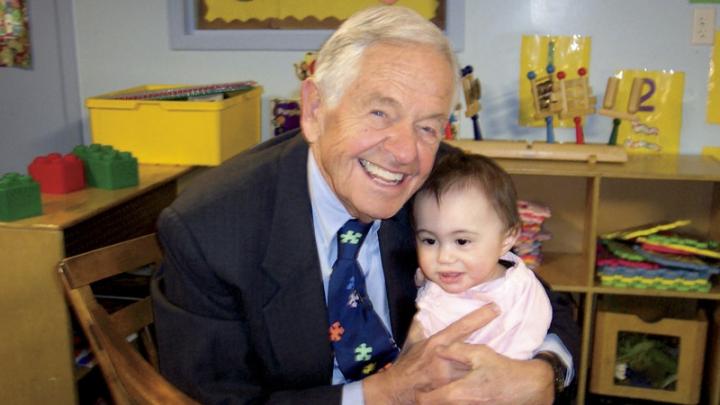When t. berry brazelton began his career, finishing medical school at Columbia University in 1943 and joining the Children’s Hospital Boston staff a few years later, after returning from the war, the common wisdom was that an infant was “a bag of neurological reflexes,” says Joshua Sparrow, associate clinical professor of psychiatry and director of strategy, planning, and program development for the Brazelton Touchpoints Center. Surgeons performed some procedures on infants without anesthesia, and infants in intensive care, routinely separated from their parents, were kept in brightly lit incubators wired with noisy alarms.
Brazelton and his contemporaries noticed, and began to incorporate into medical practice, something parents had long known: infants respond to their environment—for instance, turning their heads at the sound of a parent’s voice—and also shape their environment, provoking a parent’s action with their gaze, cries, and movement. Newborns were not blank slates, molded entirely by their parents’ behavior as some thought: even in their earliest weeks, they had distinct personalities. In 1973, Brazelton introduced the Newborn Behavioral Assessment Scale (NBAS) to elaborate and quantify the differences in temperament he had observed among the thousands of infants he had seen over the years. (His work inspired that of Starch professor of psychology emeritus Jerome Kagan; in Nurturing Children and Families, a 2010 book on Brazelton’s legacy, Kagan called Brazelton one of “a small number of prescient minds that refuse to accept the popular and often simplistic conceptualizations that dominate their discipline and insist on accommodating to what they have observed.”)
Like all Touchpoints tools, the NBAS is interactive, with contributions from both the examiner and the child being examined. Brazelton pioneered the notion that the parent’s involvement is not distracting experimental “noise,” but rather a useful part of what is being measured: the parent-child interaction. The assessment scale is used all over the world to evaluate individual infants after birth, to help new parents get to know their children, and for research (for instance, studies that investigate the effect of maternal depression on fetuses use the scale to compare children of depressed and non-depressed mothers after they are born.) Brown University professor of pediatrics Barry Lester has likened this shift (from focusing on how parents’ behavior influences babies, to considering the baby’s own behavior and innate characteristics) to the Copernican revolution: the realization that the sun, not the earth, was the center of the solar system.
In addition to his work on variation in babies’ temperament, Brazelton had a role in documenting the importance of environmental influences: one study compared mothers and infants in Japan’s remote Goto Islands to mothers in Tokyo and to Japanese mothers in San Francisco. In the islands, where pregnant women commonly sat quietly mending their husbands’ fishing nets in a rhythmic motion, babies at birth had calmer temperaments and greater ability to pay attention: they could attend to a red ball, moved in front of their faces, for a full 30 minutes. The Tokyo babies could attend to the ball for 18 minutes, and the San Francisco babies for just 12 minutes. Brazelton also recognized that these environmental differences could reverberate through later development, as a parent responds differently to a child with a short attention span than to one with a long attention span.
This notion of environment as a two-way street, affected by both parent and child, became central to Brazelton’s later work, and changed the field. For example, one study documented the increased likelihood that mothers will develop postpartum depression if their babies are especially fussy and hard to soothe, as happens when a child’s growth in utero was retarded because of a problem with the placenta. Mothers of such babies don’t get as much feedback that they’re effective at calming their children down; in a cycle that continues, the mother’s depression consequently affects the child.
Brazelton’s fascination with cultural differences in parenting helped start a shift in pediatrics from pathologizing anything that differs from a single cultural norm to asking what adaptive purpose different cultural practices might serve. For example, he and colleagues studied the Gusii people of Kenya, who do not typically engage in the intense verbal interaction that middle-class Western parents use to help their toddlers learn speech and develop cognitive skills. The researchers concluded that environmental dangers led Gusii mothers to focus more on protection than education, while older children and others in the community stimulated babies’ speech and cognition. The Touchpoints Center staff has worked closely with Native American communities as they have adapted their own versions of the Touchpoints principles specifically for their cultures and the problems they face in contemporary America, such as discrimination, cultural dislocation, unemployment, addiction, and poverty. Brazelton’s work has also helped shift the perception of special-needs children as defective, promoting the idea that children and their personalities and abilities fall along a continuum and discouraging the idea that they can be sorted into the categories of “normal” and “not normal.”










